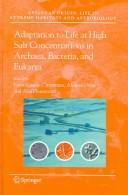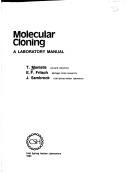| Listing 1 - 10 of 16 | << page >> |
Sort by
|
Periodical
ISSN: 16180429 09324739 Year: 1987 Publisher: [München] : Urban & Fischer
Abstract | Keywords | Export | Availability | Bookmark
 Loading...
Loading...Choose an application
- Reference Manager
- EndNote
- RefWorks (Direct export to RefWorks)
Protista --- Microbiology --- Microbiology. --- Protistes --- Protiste. --- Microbiologie. --- Protista. --- Protists --- Unicellular organisms --- Eukaryotic cells --- Infectious Disease Medicine
Book
ISBN: 0904282759 Year: 1983 Publisher: Cambridge Institute of terrestrial ecology
Abstract | Keywords | Export | Availability | Bookmark
 Loading...
Loading...Choose an application
- Reference Manager
- EndNote
- RefWorks (Direct export to RefWorks)
Amoebida --- Marine invertebrates --- Protozoa --- Protozoans --- Protozoons --- Invertebrates --- Protista --- Protozoology --- Aquatic invertebrates --- Marine animals --- Amoebaea --- Amoebina --- Lobosa
Periodical
ISSN: 16890027 Year: 1963 Publisher: Warsaw : Nencki Institute of Experimental Biology
Abstract | Keywords | Export | Availability | Bookmark
 Loading...
Loading...Choose an application
- Reference Manager
- EndNote
- RefWorks (Direct export to RefWorks)
Protozoa --- Protozoa. --- Protozoans --- Protozoons --- Invertebrates --- Protista --- Protozoology --- Eukaryota. --- Eucarya --- Eukarya --- Eukaryotes --- Eukaryotas --- Eukaryote
Periodical
ISSN: 15359786 Year: 2002 Publisher: Washington, DC : American Society for Microbiology,
Abstract | Keywords | Export | Availability | Bookmark
 Loading...
Loading...Choose an application
- Reference Manager
- EndNote
- RefWorks (Direct export to RefWorks)
Eukaryotic cells --- Eukaryotic Cells. --- Cellules eucaryotes --- Eukaryotic cells. --- Eucaryotic cells --- Cell, Eukaryotic --- Cells, Eukaryotic --- Eukaryotic Cell --- Cells --- Protista
Book
ISBN: 9400736843 9048128005 9786612331091 1282331094 9048128013 Year: 2009 Publisher: Dordrecht : Springer Netherlands : Imprint: Springer,
Abstract | Keywords | Export | Availability | Bookmark
 Loading...
Loading...Choose an application
- Reference Manager
- EndNote
- RefWorks (Direct export to RefWorks)
There is still a widespread belief that microscopic organisms, such as bacteria, fungi, protists, and small multicellulars, have a cosmopolitan distribution due to a presumed easy dispersal by wind and water. However, the contributions collected in this book – ranging from protists to rotifers and mosses – show that microorganisms have community structures and biogeographies similar to those found in animals and vascular plants, although the ranges of many can be wider and local endemism is rarer. Accordingly, the cosmopolitan distribution model of Finlay & Fenchel is to be replaced by the moderate endemicity model of Foissner, which assumes that one third of microscopic organisms are morphological and/or genetic endemics. This has far-reaching consequences for estimates of the number of species and their conservation. There is convincing evidence that we know only about 20% of the actual diversity in many protist groups, especially saprotrophs and heterotrophs such as amoebae, flagellates, and ciliates. It is probable that this great diversity of microscopic organisms is caused by low extinction rates over geological time, and short generation times which foster dispersal of genetic variants. That the great diversity of microorganisms has remained unrecognized for such a long time has several reasons, of which the most serious is a shortage of taxonomists. Considering the dramatic losses of habitats occurring, especially in the tropics, a large portion of the Earth’s protist biodiversity will disappear before it has been discovered. Reprinted from Biodiversity and Conservation, volume 17:2 (2008).
Protista -- Ecology. --- Protista -- Geographical distribution. --- Protista. --- Protozoa. --- Protista --- Biology --- Earth & Environmental Sciences --- Health & Biological Sciences --- Microbiology & Immunology --- Ecology --- Geographical distribution --- Microbial diversity. --- Microbiology. --- Protozoans --- Protozoons --- Protists --- Microbial biology --- Diversity, Microbial --- Microbiodiversity --- Microbiological diversity --- Life sciences. --- Ecology. --- Biodiversity. --- Conservation biology. --- Life Sciences. --- Conservation Biology/Ecology. --- Microorganisms --- Invertebrates --- Protozoology --- Unicellular organisms --- Eukaryotic cells --- Biodiversity --- Biological diversification --- Biological diversity --- Biotic diversity --- Diversification, Biological --- Diversity, Biological --- Biocomplexity --- Ecological heterogeneity --- Numbers of species --- Nature conservation --- Balance of nature --- Bionomics --- Ecological processes --- Ecological science --- Ecological sciences --- Environment --- Environmental biology --- Oecology --- Environmental sciences --- Population biology --- Ecology .
Periodical
Abstract | Keywords | Export | Availability | Bookmark
 Loading...
Loading...Choose an application
- Reference Manager
- EndNote
- RefWorks (Direct export to RefWorks)
International forum for reporting substantial and novel findings in any area of research on protists. Suitable subject areas include: molecular, cell and developmental biology, biochemistry, systematics and phylogeny, and ecology of autotrophic and heterotrophic protists
Protista --- Protozoa --- Eukaryota --- Protistes --- Protozoaires --- Protista. --- Protozoa. --- Einzeller --- Zeitschrift --- Protiste. --- Protozoaire. --- Eucarya --- Eukarya --- Eukaryotes --- Eukaryotas --- Eukaryote --- Periodikum --- Zeitschriften --- Presse --- Fortlaufendes Sammelwerk --- Protisten --- Organismus --- Protozoans --- Protozoons --- Invertebrates --- Protozoology --- Protists --- Unicellular organisms --- Eukaryotic cells --- Cryptogamia --- Chemistry --- Engineering --- Environmental Sciences --- Life Sciences --- Biochemistry --- Biotechnology --- Ecosystems & Ecology --- General and Others --- Zoology --- Parasites --- Antiprotozoal Agents.
Periodical
ISSN: 15507408 10665234 Year: 1993 Publisher: Danvers, MA : The International Society of Protistologists.
Abstract | Keywords | Export | Availability | Bookmark
 Loading...
Loading...Choose an application
- Reference Manager
- EndNote
- RefWorks (Direct export to RefWorks)
Protozoology --- Eukaryota --- Eukaryotic cells --- Protozoologie --- Cellules eucaryotes --- Protozoaires --- Eukaryotic cells. --- Protozoology. --- Eukaryotic Cells. --- Eucaryotic cells --- Cell, Eukaryotic --- Cells, Eukaryotic --- Eukaryotic Cell --- Eukaryotic Cells --- Cells --- Protista --- Microbiology --- Protozoa --- Zoology --- Cellules eucaryotes. --- Protozoans --- Protozoons --- Invertebrates --- Protozoa.

ISBN: 1280412542 9786610412549 1402036337 1402036329 9048169143 Year: 2005 Publisher: Dordrecht : Springer Netherlands : Imprint: Springer,
Abstract | Keywords | Export | Availability | Bookmark
 Loading...
Loading...Choose an application
- Reference Manager
- EndNote
- RefWorks (Direct export to RefWorks)
Salt is an essential requirement of life. Already from ancient times (e. g. , see the books of the Bible) its importance in human life has been known. For example, salt symbolizes destruction (as in Sodom and Gomorra), but on the other hand it has been an ingredient of every sacrifice during the Holy Temple periods. Microbial life in concentrated salt solutions has fascinated scientists since its discovery. Recently there have been several international meetings and books devoted entirely to halophiles. This book includes the proceedings of the “Halophiles 2004” conference held in Ljubljana, Slovenia, in September 2004 (www. u- lj. si/~bfbhaloph/index. html). This meeting was attended by 120 participants from 25 countries. The editors have selected presentations given at the meeting for this volume, and have also invited a number of contributions from experts who had not been present in Ljubljana. This book complements “Halophilic Microorganisms”, edited by A. Ventosa and published by Springer-Verlag (2004), “Halophilic Microorganism and their Environments” by A. Oren (2002), published by Kluwer Academic Publishers as volume 5 of “Cellular Origins, Life in Extreme Habitats and Astrobiology” (COLE), and “Microbiology and Biogeochemistry of Hypersaline Environments” edited by A. Oren, and published by CRC Press, Boca Raton (1999). Salt-loving (halophilic) microorganisms grow in salt solutions above seawater salinity (~3. 5% salt) up to saturation ranges (i. e. , around 35% salt). High concentrations of salt occur in natural environments (e. g.
Archaebacteria --- Bacteria --- Eukaryotic cells --- Extreme environments --- Effect of salt on. --- Microbiology. --- Extremophiles (Microbiology) --- Geomicrobiology --- Microbial ecology --- Extremozymes --- Eucaryotic cells --- Cells --- Protista --- Germs --- Microbes --- Prokaryotes --- Archaea --- Archaeobacteria --- Biochemistry. --- Biochemistry, general. --- Biological chemistry --- Chemical composition of organisms --- Organisms --- Physiological chemistry --- Biology --- Chemistry --- Medical sciences --- Microbial biology --- Microorganisms --- Composition
Periodical
Abstract | Keywords | Export | Availability | Bookmark
 Loading...
Loading...Choose an application
- Reference Manager
- EndNote
- RefWorks (Direct export to RefWorks)
1 Vol. (4 issues) / year
Protozoans --- Biology --- Cryptogamia --- Protozoa --- Protozoaires --- Periodicals --- Périodiques --- Microbiology --- Eukaryota --- Protistologie. --- 57 --- Biological sciences in general --- Life Sciences --- Zoology --- dead periodical --- Périodiques --- ELSEVIER-E EPUB-ALPHA-A EPUB-PER-FT --- Protozoons --- Infectious Disease Medicine --- Invertebrates --- Protista --- Protozoology --- Periodicals. --- Eukaryota. --- Microbiology. --- Eucarya --- Eukarya --- Eukaryotes --- Eukaryotas --- Eukaryote

ISBN: 0879691360 9780879691363 Year: 1982 Publisher: New York : Cold Spinger Harbor Laboratory,
Abstract | Keywords | Export | Availability | Bookmark
 Loading...
Loading...Choose an application
- Reference Manager
- EndNote
- RefWorks (Direct export to RefWorks)
Molecular biology --- molecular cloning --- Cloning, Molecular. --- Clone cells --- Molecular Cloning --- Cosmids --- Cloning, Organism --- Eukaryotic cells. --- Eucaryotic cells --- Biological techniques --- Molecular cloning. --- Basic Sciences. Molecular Biology --- Molecular Biology (General). --- Eukaryotic cells --- Molecular cloning --- Cloning, Molecular --- DNA cloning --- Gene cloning --- Cloning --- Genetic engineering --- Molecular genetics --- Cells --- Protista --- #abib:almm --- DNA --- Amino Acid Sequence --- Eukaryotic Cells --- Methods
| Listing 1 - 10 of 16 | << page >> |
Sort by
|

 Search
Search Feedback
Feedback About
About Help
Help News
News